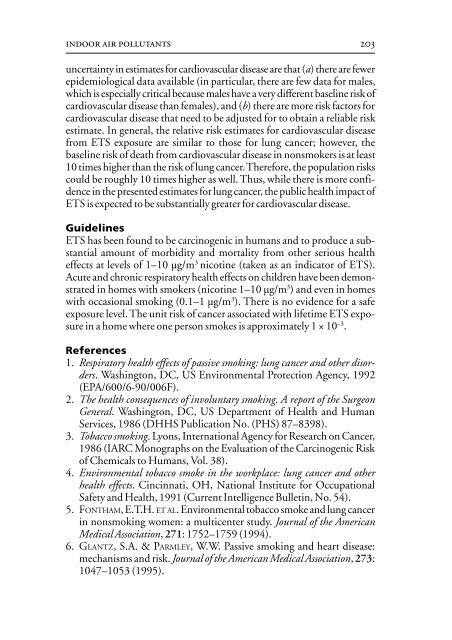Air Quality Guidelines - World Health Organization Regional Office ...
Air Quality Guidelines - World Health Organization Regional Office ...
Air Quality Guidelines - World Health Organization Regional Office ...
You also want an ePaper? Increase the reach of your titles
YUMPU automatically turns print PDFs into web optimized ePapers that Google loves.
indoor air pollutants<br />
203<br />
uncertainty in estimates for cardiovascular disease are that (a) there are fewer<br />
epidemiological data available (in particular, there are few data for males,<br />
which is especially critical because males have a very different baseline risk of<br />
cardiovascular disease than females), and (b) there are more risk factors for<br />
cardiovascular disease that need to be adjusted for to obtain a reliable risk<br />
estimate. In general, the relative risk estimates for cardiovascular disease<br />
from ETS exposure are similar to those for lung cancer; however, the<br />
baseline risk of death from cardiovascular disease in nonsmokers is at least<br />
10 times higher than the risk of lung cancer. Therefore, the population risks<br />
could be roughly 10 times higher as well. Thus, while there is more confidence<br />
in the presented estimates for lung cancer, the public health impact of<br />
ETS is expected to be substantially greater for cardiovascular disease.<br />
<strong>Guidelines</strong><br />
ETS has been found to be carcinogenic in humans and to produce a substantial<br />
amount of morbidity and mortality from other serious health<br />
effects at levels of 1–10 µg/m 3 nicotine (taken as an indicator of ETS).<br />
Acute and chronic respiratory health effects on children have been demonstrated<br />
in homes with smokers (nicotine 1–10 µg/m 3 ) and even in homes<br />
with occasional smoking (0.1–1 µg/m 3 ). There is no evidence for a safe<br />
exposure level. The unit risk of cancer associated with lifetime ETS exposure<br />
in a home where one person smokes is approximately 1 × 10 –3 .<br />
References<br />
1. Respiratory health effects of passive smoking: lung cancer and other disorders.<br />
Washington, DC, US Environmental Protection Agency, 1992<br />
(EPA/600/6-90/006F).<br />
2. The health consequences of involuntary smoking. A report of the Surgeon<br />
General. Washington, DC, US Department of <strong>Health</strong> and Human<br />
Services, 1986 (DHHS Publication No. (PHS) 87–8398).<br />
3. Tobacco smoking. Lyons, International Agency for Research on Cancer,<br />
1986 (IARC Monographs on the Evaluation of the Carcinogenic Risk<br />
of Chemicals to Humans, Vol. 38).<br />
4. Environmental tobacco smoke in the workplace: lung cancer and other<br />
health effects. Cincinnati, OH, National Institute for Occupational<br />
Safety and <strong>Health</strong>, 1991 (Current Intelligence Bulletin, No. 54).<br />
5. FONTHAM, E.T.H. ET AL. Environmental tobacco smoke and lung cancer<br />
in nonsmoking women: a multicenter study. Journal of the American<br />
Medical Association, 271: 1752–1759 (1994).<br />
6. GLANTZ, S.A. & PARMLEY, W.W. Passive smoking and heart disease:<br />
mechanisms and risk. Journal of the American Medical Association, 273:<br />
1047–1053 (1995).

















